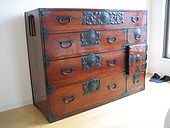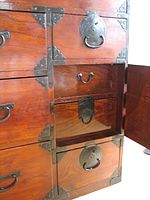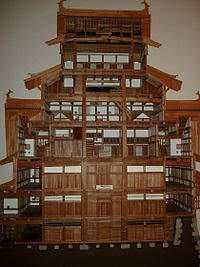- Tansu
-
Tansu is the word for chest, chest of drawers or cupboard in Japanese. It is often used in the West to refer to traditional Japanese chests, handcrafted and made of fine woods, such as Hinoki (Japanese cypress), Keyaki (Japanese elm), Kuri (Japanese chestnut), Sugi (Japanese cedar) and Kiri (Paulownia).
Many collectors focus on finding antique Tansu. There are many workshops producing Tansu in imitation of the classic antiques. Some are made of excellent reclaimed wood, causing the new Tansu to retain a more aged look that some people seek.
Contents
Types of tansu
- Choba-dansu Were used by Chonin - Merchants, these chests display elaborate metal hardware, and were traditionally used in shops to impress customers. These chests do come in many sizes, serving everything from storage for sewing supplies, sea chests, merchant chests, and up to large ones for storage of futons and kitchen equipment. Sometimes these chests open only on a single side, but others are notable for being accessible from both sides, leading to quite a wide variety of options in interior design.
- Kusuri-dansu are apothecary chest. They were used to store herbs which would be made into prescriptions by the pharmacist. They are often made of Kiri wood and have many small drawers.
- The Kaidan-dansu (or step-chests as they are sometimes called) were often designed in several modular pieces. This was used to avoid taxation on other areas of a home when taxes were levied based on the size of ones home. When the tax collectors were coming around the chest that functioned as stairs up to a separate level could be moved so that their function could be hidden.[citation needed]
- Katana-dansu were used to store swords. These chests were long and low and owned by Samurai families. Quite often the wood used in these chests was Kiri because it kept swords from rusting in the humid Japanese summers.
- Mizuya-dansu or daidokoro-dana were used in kitchens for the storage of plates, utensils and food items. Most kitchen chests will not have locks and will be a combination of sliding doors and drawers.
- Sendai-dansu are chests used to store kimono and clothing. They originated from craftsmen in the Sendai region, and are often made of zelkova wood with drawers lined in cedar. Sendai-dansu are characterised by one long top drawer, with three slightly smaller drawers underneath. There is usually a lockable door containing two smaller drawers. Sendai-dansu are known for their elaborate ironwork - commissioned from former sword makers after the Samurai were disbanded in the Meiji era.
- Kuruma-dansu are any chest with wheels. Fire was a major hazard in the Edo period. Early in the Edo era the most valuable items from a family or business were stored in a wheeled chest that was pulled outside when the home or business caught fire. The earliest style was Karuma-nagamochi or long trunk on wheels. As a result of the role these chests played in the great number of deaths in the Meireiki fire in Edo in 1657 this style of tansu was forbidden in Edo, Osaka, and Kyoto. Later more specific styles were developed for specific uses and regionally.
- Cha-dansu were used to store tea ceremony implements. Because the tea ceremony was important these chests were often left inside the home to act as both a storage and display cabinet. For this reason most are made of finely figured woods.
- Funa-dansu, literally "ship chests", were used as shipping containers from the Edo period into the Meiji Era. These came in three basic designs:
- kakesuzuri - a small chest with a single swinging door, with multiple internal drawers inside
- hangai - literally "half hitsu" (coffer), a small chest used for clothing storage. Often made in sets of two, with one stacked above the other.
- cho-bako - "account box", which had many forms, but could include:
- kendon-buta - a drop-fit door cut into the case, used to hide a money box
- kobiraki-do - a small swinging door in the lower-right corner
- ryobiraki-do - double doors with half-faced hinges on the lower half of the box
- dezura hikidashi - one or two drawers, exposed to the exterior
- hiki-do - removable double sliding doors, running the full width of the box, appearing on the top third or middle third of the box
- zuri-do - removable single sliding door in the lower half of the box, in the lower-left. Typically appears with a kobiraki-do
Regional types
Many regions of Japan made tansu. The castle towns on the post roads commonly became trade centers and developed distinctive styles. There are a few main characteristics to look for in determining the origin of a tansu. The ironwork: most towns used one or just a few styles of locks and hardware. Configuration: the majority of tansu from a region will display the same configuration of drawers and construction. clothing chests will look like other clothing chests and kitchen chest will look like other kitchen chests etc. Wood and Lacquer types are also clues to the origin of some pieces.
Types of hardware
The elements of antique tansu hardware were created from forged iron, with on some occasions copper being used. The flat pieces were chiseled from forged iron plates and subsequent design elements engraved or inlaid. The black finish on the iron was created by applying rapeseed oil to the hot metal.[1]
- herikanagu - edge hardware, lining the edges and corners of a tansu
- obikanagu - "sash hardware" which spans a face of the tansu, such as the top, or the face of a cabinet door
- sumikanagu - drawer or drawer-corner hardware, appearing at the corners of drawer faces. Generally these match their associated edge hardware.
- mochiokuri - a carrying handle, generally a loop appearing on the side near the top
- sao-toshi - a different type of carrying loop, usually sliding, which was designed to hold a pole when used with its mate on the other side
- meita - a lock jamb plate
- jomae - a lock plate, a metal, lockable plate affixed to a drawer face
- sashikomijo - a sliding-door lock
- bo - a vertical locking bar
- hikite - drawer pull
- zagane - an "escutcheon," or flange, surrounding the contact point of a drawer pull
- toshi-zagane - a back plate for a drawer pull
- choban - hinge
- kasugai - a staple affixing hardware to the wood
- jomon - family crest, identifying the merchant
- yago - a trademark, identifying the merchant
References
- ^ Heinekin, Ty (1981). Tansu: Traditional Japanese Cabinetry. Page: 187, 196. Publisher: Weatherhill Inc., New York
Additional reading
- Japanese Cabinetry - the art and craft of Tansu by David Jackson and Dane Owen, Gibbs-Smith Publisher 2002
External links
- Kateigaho - Article detailing many features of Tansu
- Stanford JGuide - Crafts & Antiques section -(Many links to informational sources on Tansu and related topics)
Elements of Japanese architecture Styles Buddhist · Buke · Daibutsuyō · Gassho · Giyōfū · Hachiman · Hirairi · Hiyoshi (also called Hie) · Irimoya · Ishi-no-ma · Kasuga · Kibitsu · Nagare · Ōbaku Zen · Setchūyō · Shinden · Shinmei · Shinto · Shoin · Sukiya · Sumiyoshi · Taisha · Wayō · ZenshūyōA model of Himeji Castle
Building types Roof styles Structural Burdock piling · Chigi · Disordered piling · Engawa · Fusuma · Hisashi · Irimoya-zukuri · Irori · Jinmaku · Katōmado · Katsuogi · Kuruwa · Mokoshi · Moya · Nakazonae · Namako wall · Nightingale floor · Onigawara · Ranma · Shōji (see also washi) · Sōrin · Tamagaki · Tatami · Tokonoma · Tokyō · Tsumairi · ShibiGates and approaches Rooms Furnishings Outdoor objects Measurements Groups See also en:Tansu
Categories:- Japanese home
- Furniture
- Cabinets
- Clothing containers
Wikimedia Foundation. 2010.




